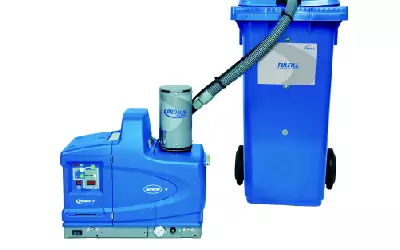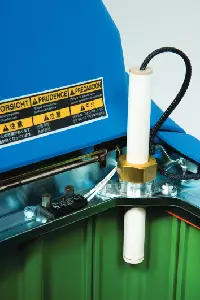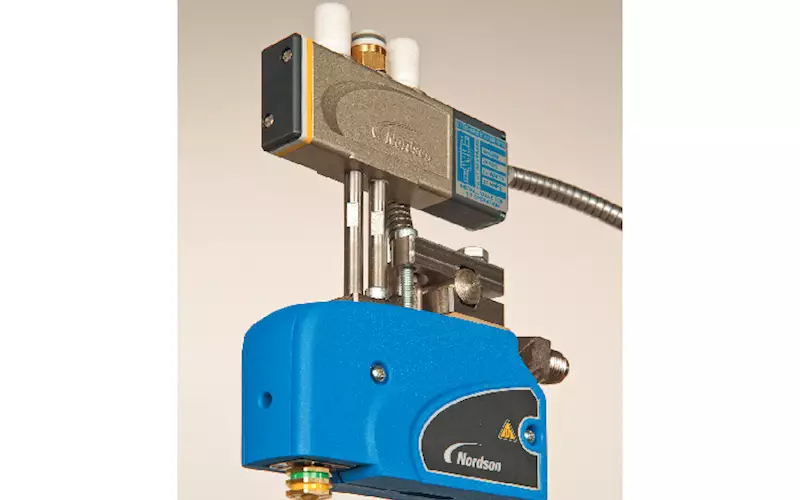Matching the right hotmelt system to your operations
This technology report by Nordson Corporation looks at what constitutes a hotmelt adhesive kit and how to go about selecting a right configuration for case sealing and tray forming applications
05 Nov 2018 | By WhatPackaging? Team
The deposition of thermoplastic (hotmelt) adhesives is the preferred method for carton sealing, case sealing, tray forming and a host of other packaging applications.
All hotmelt adhesive systems employ a melting device to transform solid adhesive in pellet, pastille, pillow, block, slat or other forms, to a liquid state required for dispensing. They also contain a pump, which pressurises the molten adhesive. While sometimes called a tank, unit, system or applicator, the most globally recognised term is adhesive melter.
A heated transfer hose carries the molten adhesive, at the application temperature, preventing it from returning to its solid form, moving it from the melter to an application device.
The application device sometimes referred to as a valve, gun, manifold or dispenser, more correctly called the adhesive applicator, deposits molten adhesive onto the package or container flap(s). When a second flap is brought into contact with the first, the molten adhesive cools and creates a bond between the surfaces.
A distance- or time-based adhesive pattern control activates the adhesive applicator and manages the precise placement of adhesive beads, dots or short/modulated beads using a pre-determined program.
Beyond basic functionality, production environment and application requirements greatly impact melter selection. Fortunately, a wide variety of melters with a choice of system controls, melt technologies, tank capacities, pump types and output connections are readily available to today’s packagers.
Adhesive melter types
There are three primary melter types. While all three melt and pump adhesives, some are more flexible and considered better suited for packaging operations.
- Grid and reservoir melters with tank capacities from 12 to 100 litres offer robust, higher-watt heaters and can be used in applications that require higher adhesive melt rates and throughput.
- Bulk melters that use heated platens to melt and pump adhesive directly from 5-gallon/20-litre pails up to 55-gallon/200- litre drums typically have melt/throughput rates and energy requirements that preclude their efficient use in packaging operations.
- Tank-style melters with capacities from 4 to 10 litres are most common but, sizes up to 100 litres are also available. Melt rates from 4.3 to 11 kg/hr (9.5 to 24 lbs) and throughput rates of 6 to 12 kg/hr (15 to 27 lbs) are readily available.
Packaging-grade hotmelt adhesives are available in formulations that permit melting and application at temperatures ranging from as low as 200º F (93º C) to over 375º F (190º C).
Heat generated in the bottom of the tank is conducted up the tank’s side walls and is transferred from the heated surfaces to the adhesive. Metal fins inside the tank are often used to attain more heat- conducting surface area and better heat transfer to the adhesive.
Electronic temperature controls within the melter compare the temperature of the adhesive in different areas or zones to the temperature setting and activate tank heaters as needed before the adhesive cools. To help assure the bonding characteristics of your adhesive and the quality of your packages, melters with temperature control stability of +/- 1 º F (0.5 º C) are highly recommended.

Tank-style melters for pacakgaing applications
Compared to grid and reservoir melters and bulk melters, tank melters are typically more compact in size. A smaller footprint provides easier installation and operation in parent packaging machinery.
Tank-style melters easily accommodate a wide variety of adhesive shapes and sizes allowing packagers to change adhesive types to meet different package needs over time.
The best melter tank designs for packaging:
- Minimise sharp corners where adhesive can become trapped and degrade. This reduces adhesive char, nozzle clogging, debris on packages, maintenance and downtime
- Use non-stick surfaces for easier cleaning
- Provide easy tank access from three sides
Pump types
Choosing the correct melter for your packaging application will include determining whether an electric-motor-driven pump or a pneumatic-driven pump best suits your needs.
Consider these factors when deciding between electric or pneumatic melters:
- Adhesive type
- Adhesive viscosity ranges
- Environment and availability of factory air
- Level of adhesive output precision required
- Need for continuous or intermittent adhesive output
- Line speed
- User preferences
Calculating adhesive demand
The amount of adhesive you need to dispense is a key factor in selecting the right adhesive melter for your operation. Amount of adhesive per package, packaging line speed and the number of packages per hour will determine your melt rate and throughput needs.
To get started calculating your adhesive requirements, you will need to know what it takes to securely seal your package.
Determine the amount of adhesive per product, per production hour and per day by calculating:
- Number of adhesive beads/product
- Length of each bead
- Bead diameter(s)
- Number of packages you want to seal per day hour
An automatic, on-line adhesive calculator can help you do this with ease: www.nordson.com/en/divisions/adhesive-dispensing-systems/service-and-support/calculators

Pneumatic piston pumps
Piston pumps use compressed air to activate an air piston which moves a hydraulic plunger. The simple design requires no gear reducers or electric drive mechanisms and provides long, dependable service life.
The piston creates a continuous, even hydraulic pressure which pushes (transports) the molten adhesive on demand.
Adhesive output can be increased or decreased by simply increasing or decreasing the air pressure to the piston pump. Increasing air pressure increases the hydraulic pressure which moves the adhesive through the hose to the applicator, allowing more adhesive to be dispensed at any given time. Similarly, decreasing air pressure results in less adhesive being dispensed.
Piston pumps stroke only when the adhesive is being used and are at rest when the adhesive is not needed, resulting in long service life.
In single-action piston pumps (also called shot pumps), the adhesive is pumped as the piston strokes in one direction only. A pause in the pumping action occurs as the piston returns to its original position before beginning the next stroke. Single-action pumps are used when larger amounts of adhesive are dispensed and there is time between products for the pump to reset. While less costly, single-action pumps do not meet the line-speed requirements of most packaging operations.
Double-action pumps pressurise adhesive during both directions of the pump stroke(s). The instantaneous and virtually unnoticeable pause that occurs as the piston changes direction at the end of each stroke usually has no effect on adhesive output.
If a piston pump melter best meets your needs, be sure to insist on a melter with an automatic pressure discharge. Piston pumps create hydraulic pressure typically ranging from 250 to 800 psi (17.2 to 55.2 bar). An automatic pressure discharge safely releases residual pressure back into the melter tank in seconds.
Electric gerotor pumps
A gerotor (short for generated-rotor) pump operates using a larger outer gear ring and a smaller inner gear that has one less tooth than the outer gear. The inner and outer gears both rotate in a clockwise direction but, on different, fixed centerlines. As the gears rotate, the spaces between the teeth change, creating pockets or chambers.
During the gears’ rotation cycle, the size of the chambers changes continuously. Total available chamber volume increases, creating a vacuum and adhesive intake.
Adhesive enters the inlet port, filling a chamber between the two gears. As the gears rotate, additional chambers between the gears fill with adhesive as they pass the inlet port.
As total available chamber volume decreases, compression occurs and the inner gear forces adhesive from individual chambers through the pump outlet producing positive-displacement, continuous adhesive flow at constant speed. Their gear-and-chamber design and operation allow gerotor pumps to process a broad range of adhesives with widely ranging viscosities.
Because they do not require factory air, gerotor pumps are suitable for many remote, on-site and agricultural packaging operations where only electricity is available.
While seemingly more economical than piston pumps or spur-gear pumps, gerotor pumps deliver less precision and line speed flexibility, limiting their use to lower-volume, less demanding and manual dispensing applications.
Common adhesive melter choices by application and adhesive use
(For example only. Your specific operation and needs will determine your choice.)
| Operation | Adhesive applicator |
Pump type |
Melter |
|
Carton Sealing |
Pneumatic bead | Piston |
10-litre pneumatic |
| Carton Sealing | Pneumatic bead | Piston |
4-litre pneumatic |
| Tray forming | Pneumatic bead | Piston |
10-litre pneumatic |
| Bliss box forming | Pneumatic bead | Piston |
7-litre pneumatic |
| Sift-proof carton sealing | Electric multi-bead | Piston or Spur gear |
30-litre pneumatic |
| Beverage case sealing | Pneumatic bead | Spur gear |
50-litre pneumatic |
| Agricultural case sealing | Pneumatic bead | Piston (single acting) |
15-litre pneumatic |
| Speciality packaging | Electric dots | Piston |
4-litre |
Your equipment supplier will be able to assist you in refining your exact needs, specifications and the melter that will meet and exceed your productivity and total cost of operation goals.
Electric spur-gear pumps
Spur-gear pumps are positive displacement pumps that employ meshing, counter-rotating gears in a housing.
A drive gear, attached to a power source is turned in a counter- clockwise direction. The gear it is driving (the idle gear) turns clockwise.
The rotating gears create a partial vacuum as the gear teeth come apart/un-mesh, drawing adhesive into the inlet side of the pump, between the gears and the housing.
The adhesive is carried in the spaces between the gear teeth, around the housing to the outlet port. When the gear teeth mesh again, an increase in pressure occurs, pushing the adhesive that was between the teeth out a pump port.
A constant amount of adhesive is output with each complete revolution of the gears.

Spur-gear pumps accommodate a wide range of material viscosities and are well-suited for applications like beverage packaging which require high-volume and high-speed, high-precision adhesive output.
Spur-gear pumps are commonly coupled with variable-speed drives to provide flexibility and synchronisation of adhesive output to production line speeds.
Additionally, pump sizes can be specified for various outputs. In some instances, multiple pumps are utilised to meet high output requirements or provide a variety of output rates from a single melter.
Melter controls
Controls have advanced dramatically since the introduction of hotmelt dispensing systems in the mid-1960’s. Today’s melters are available with control packages ranging from simple on/off switches to programmable systems that monitor and control multiple temperature zones, production speeds and communication interfaces.
- Complementing these technological advances, packagers can benefit from selecting melters that feature:
- Intuitive controls that allow operation at virtually any skill or language ability level
- At-a-glance graphic interfaces for operators to monitor, ready, fault, service and temperature for the melter tank, hose and gun
- Graphical service indicators for filter replacement and low adhesive level
- Serial and network communications capabilities that provide easy integration into parent packaging machinery and system controls
- Parent machine interlocks that prevent parent machinery from operating until the adhesive melter is ready
- Sequential start-up of melter heating zones to prevent adhesive melting and expansion from creating damaging pressure in the melter, hose and applicator
- Remote monitoring ranging from one operator controlling a single melter – to Fieldbus connectivity (EtherNet/IP, PROFIBUS-DP, DeviceNet) where programming and monitoring of several melters on multiple production lines in different geographic locations is done from a single location
- Seven-day-clocks that provide significant energy savings through the automatic start up and shut down when the melter is not in use
- Temperature setback that delivers adhesive cost, maintenance and energy savings by lowering the melter temperature when the packaging line is stopped, maximising adhesive life and reducing adhesive charring
Automatic adhesive filling/refillingTraditionally, hotmelt adhesives were manually fed into the tank or hopper of the adhesive melter. In recent years, this practice has been replaced with automatic filling/refilling systems that improve worker safety, increase efficiency and minimize waste.
In principle, the automatic filling is a simple concept. A sensing device continuously monitors adhesive volume in the melter tank and sends a signal when a pre-determined low level is reached. The signal triggers the filling system to automatically add adhesive typically, 8 to 16 ounces (0.25 to 0.50 litres) to the melter tank. This occurs every few minutes without operator intervention, keeping the adhesive level within the tank relatively constant.
The economic benefits and rapid return on investment make automatic adhesive filling systems an attractive option for virtually all but very low-volume or manual packaging operations.
- Minimal potential for human error – including overfilling, adhesive spilling/waste or low/dry adhesive tanks that result in poor bonding and reject packages
- Labour savings – as operators are freed from manual monitoring and filling, they become available for other production activities and tasks
- Correct, constant adhesive temperature and viscosity – accomplished by adding small amounts of adhesive at needed intervals, prolongs adhesive, melter, hose and applicator life while increasing package bonding consistency
- Adhesive and maintenance savings – result from the elimination of open melter tank lids that can allow debris and contaminants into the adhesive tank and system
- Improved safety – by eliminating frequent bending and lifting of adhesive containers, and limiting operator interaction with molten adhesive
- Provide a return on investment – by minimising adhesive, labour and waste to decrease total operational and production costs while improving package bonding integrity and quality
- Flexibility for the Future-While any adhesive melter will melt and pump adhesive, it is important to select one that not only meets current needs but also has the features and flexibility to meet multiple, future packaging application requirements.

Features to look for include:
- Hose and applicator flexibility
a. Plug-in hose/gun modules – allow the addition or subtraction of the number of hoses and applicators from as few as 1 to as many as 6 on a single melter
b. Expansion base capabilities are also available for some melters permitting up to 8 hose/applicator connections - Quick-disconnect input/output plugs – with programmable input and outputs
- Quick-release base – permits a melter to be easily disconnected and moved
- Transformer option, for a 240-volt melter that accept inputs of 400 and 480 volts AC, eliminates the need for a secondary transformer installation on the parent machine and expands global capabilities
- Piston pump flexibility – for lower volume applications that can use a 6:1 pump rather than the standard 15:1 pump.
This White Paper has been produced by Nordson Corporation (www.nordsonadhesive.com) and has been approved by the WhatPackaging? editorial team











 See All
See All